|
||||||||||||||||||||||||||||||||||||||||||||||||||||||||||||||||||||||
|
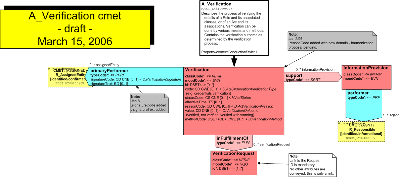
| Parent: | Personnel Management (PRPM_DM000000UV) |
This cmet describes the process of verifying the details of a Role and its associated classes, or of an Act and its associations. The model supports description of means and methods of verification and the outcome of the process. Neither the Role not the Act subject is included in this model but is assumed to be present in the domain model in which the cmet is used.
-
Verification: An act that identifies the verification event. The verification process and results are described through classes associated with this Act. Verification is the activity of confirming the existence and characteristics of a Role (usu. attested to by a Credential or other token), or of an Act and its dependent associations.
Attributes
-
id: identifier for the verification event
-
code: code identifying the type of verification. The ActVerificationTypeCode domain covers concepts such as:
-
Verification of eligibility for coverage under a policy or program - aka enrolled/covered by a policy or program
-
Verification of record - e.g., person has record in an immunization registry
-
Verification of enumeration - e.g. NPI
-
Verification of Board Certification - provider specific
-
Verification of Certification - e.g. JAHCO, NCQA, URAC
-
Verification of Conformance - e.g. entity use with HIPAA, conformant to the CCHIT EHR system criteria
-
Verification of Provider Credentials
-
Verification of no adverse findings - e.g. on National Provider Data Bank, Health Integrity Protection Data Base (HIPDB)
-
-
effectiveTime: time of the verification event
inFullfillmentOf Act Relationship: This relationship associates a verification event with zero to many VerificationRequests.
PrimaryPerformer Participation: The person, organization or device that actually performed the verification, and the organization they represent, are identified via this participation.
Support Act Relationship: A verification act can have optional corroborating information (an InformationProvision act) supplied by a performing person, organization or device.
-
-
InformationProvision: an act describing the provision of corroborating information. The model does not include any descriptive attributes for this act, apart from identifying the performer. The performer participation is therefore 'Required'.
Performer Participation: identifies the party (R_Responsible) that supplied the corroborating information.
-
R_Responsible Identified/Informational (cmet): The R_Responsible cmet describes the agent that supplied supporting information for the verification process. This version of the cmet has a mandatory id for the agent role, which normally will be known to sender and receiver of a message. However, some optional descriptive information about the player and scoper of the role are supported in the cmet. An agent can be a Person, Organization or a Device.
-
VerificationRequest: An act identifying a request for verification. Apart from an event identifier the particulars of the request are not supported in this model. A single verification event can fulfill multiple verification requests.
Attributes:
-
id: identifier(s) for the verification request
-
-
VerificationResult:
Attributes:
-
code: identifies the observation act as a Verification result via the VerificationResultType domain
o/s action item for PM to submit proposal for new domain, VerificationResultType. May require further specializations eg. 'AdministrativeVerification', and if so the domain in the model will be changed.
-
value: coded value for actual outcome of the verification process e.g. 'verified', 'not verified', 'verified with warning'
value attribute constrained to CE datatype to meet known requirements. o/s action item for PM to submit proposal for new domain, VerificationOutcome, as a a specialization of ObservationValue.
-
methodcode: identifies the method by which the results were obtained e.g. 'cardreader'. Usage note: this observation does not directly support any information about who/what obtained the results. Implementers requiring data about the source of the observation(s) must constrain the model to require the InformationProvision act and associated R_Responsible party.
o/s action item for FM committee to submit domain definition for VerificationMethod: Suggested def'n: "method by which information is obtained to determine the factualness of a subject Act or Role"
SubjectOf Act Relationship: Associates the Observation reporting the verification results with Verification event. Note that there can be only one Verification Result.
-
-
R_AssignedEntity (cmet): The assigned entity cmet describes the primary performer of the verification. This version (COCT_MT090002) of the R_AssignedEntity cmet contains only minimal attributes for identifying a known role, the entity playing the role (person, organization or device) and the organization that scopes the role.
o/s action item for PM to reconcile this cmet to PRPM DMIM
| R_ResponsibleIdentified/informational | COCT_MT040008UV |
| R_AssignedEntityIdentified/confirmable | COCT_MT090002UV01 |
| A_Verification universal | COCT_MT810000UV |
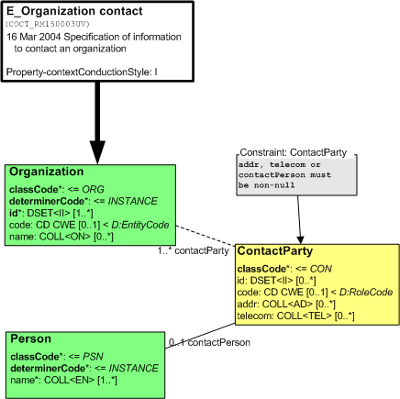
| Parent: | Personnel Management (PRPM_DM000000UV) |
This CMET is used to identifiy an organization.
This is the contact variant of E_Organization universal.
| E_Organization contact | COCT_MT150003UV03 |
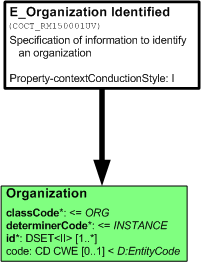
| Parent: | Personnel Management (PRPM_DM000000UV) |
This CMET is used to identifiy an organization.
This is the identified variant of E_Organization universal.
| E_Organization identified | COCT_MT150001UV01 |
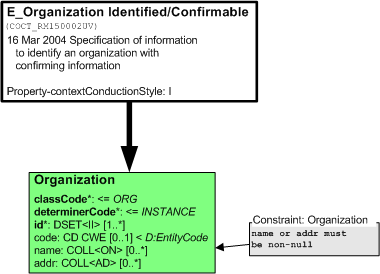
| Parent: | Personnel Management (PRPM_DM000000UV) |
This CMET is used to identifiy an organization.
This is the identified-confirmable variant of E_Organization universal.
| E_Organization identified-confirmable | COCT_MT150002UV01 |
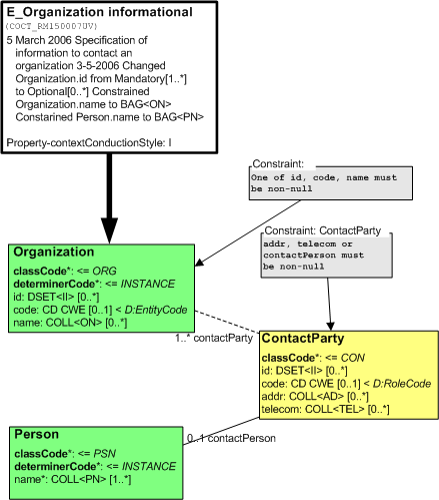
| Parent: | Personnel Management (PRPM_DM000000UV) |
This is the informational variant of E_Organization universal.
| E_Organization informational | COCT_MT150007UV |
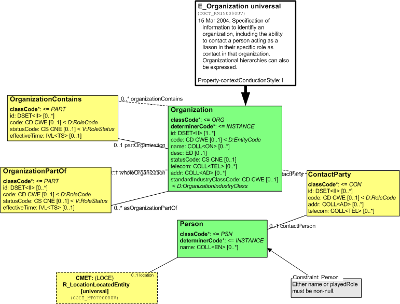
| Parent: | Personnel Management (PRPM_DM000000UV) |
Specification of information about the entity organization, a system of legally-enabled interconnections between principals. Provides enough information to contact an individual person acting as a liaison in their specific role as contact for a particular organization.
| R_LocationLocatedEntityUniversal | COCT_MT070000UV01 |
| E_Organization universal | COCT_MT150000UV02 |
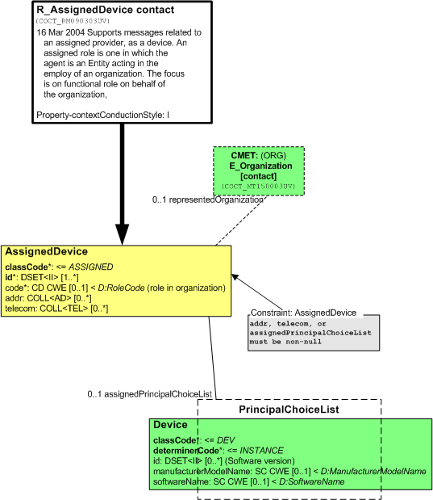
| Parent: | Personnel Management (PRPM_DM000000UV) |
The CMET is used to identify an assigned device.
This is the contact variant of R_AssignedDevice universal
| E_OrganizationContact | COCT_MT150003UV03 |
| R_AssignedDevice contact | COCT_MT090303UV01 |
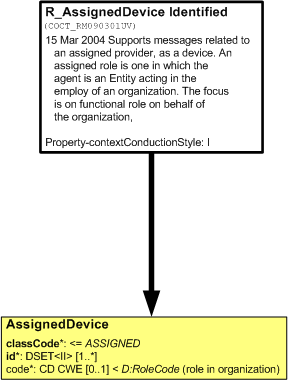
| Parent: | Personnel Management (PRPM_DM000000UV) |
The CMET is used to identify an assigned device.
This is the identified variant of R_AssignedDevice universal
| R_AssignedDevice identified | COCT_MT090301UV01 |
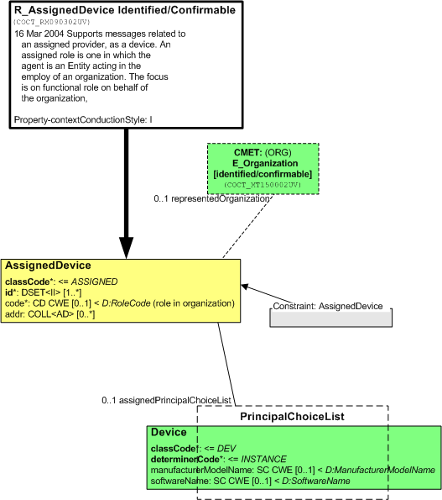
| Parent: | Personnel Management (PRPM_DM000000UV) |
This CMET is used to identified an assigned device.
This is the identified-confirmable variant of R_AssignedDevice universal
| E_OrganizationIdentified/confirmable | COCT_MT150002UV01 |
| R_AssignedDevice identified-confirmable | COCT_MT090302UV01 |
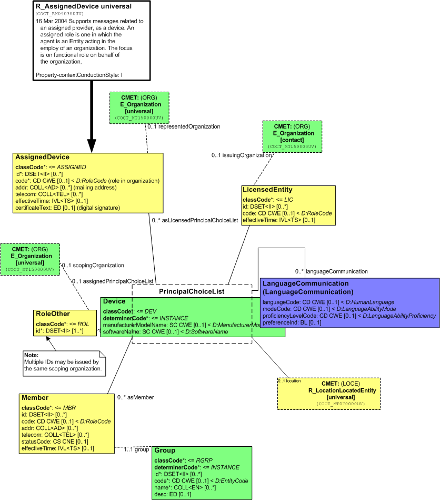
| Parent: | Personnel Management (PRPM_DM000000UV) |
This is the universal variant of the R_AssignedDevice CMET.
The CMET is used to identify an assigned device. The CMET also restricts R_AssignedEntity universal by specializing the entity choice to a device.
| R_LocationLocatedEntityUniversal | COCT_MT070000UV01 |
| E_OrganizationUniversal | COCT_MT150000UV02 |
| E_OrganizationUniversal | COCT_MT150000UV02 |
| E_OrganizationContact | COCT_MT150003UV03 |
| R_AssignedDevice universal | COCT_MT090300UV01 |
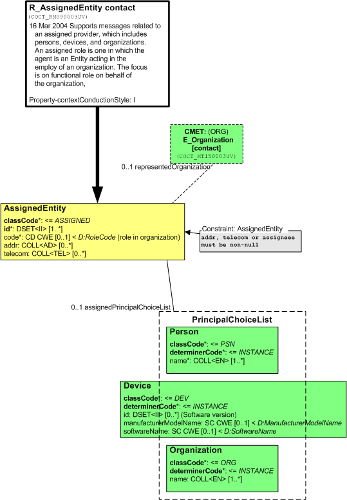
| Parent: | Personnel Management (PRPM_DM000000UV) |
This CMET is used to identifiy information about an entity -- person, organization or device -- that is assigned to a particular responsibility within the context of an HL7 message.
This is the contact variant of R_AssignedEntity universal.
| E_OrganizationContact | COCT_MT150003UV03 |
| R_AssignedEntity contact | COCT_MT090003UV01 |
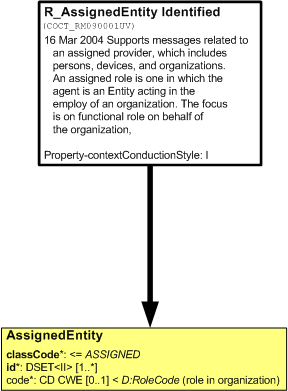
| Parent: | Personnel Management (PRPM_DM000000UV) |
This CMET is used to identifiy information about an entity -- person, organization or device -- that is assigned to a particular responsibility within the context of an HL7 message.
This is the identified variant of R_AssignedEntity universal.
| R_AssignedEntity identified | COCT_MT090001UV01 |
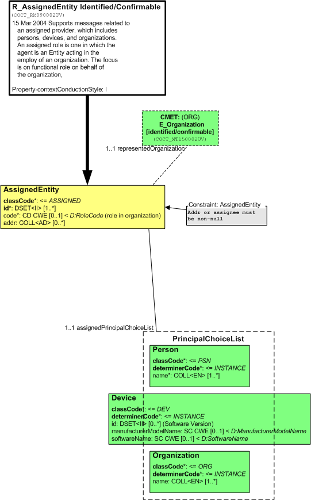
| Parent: | Personnel Management (PRPM_DM000000UV) |
This CMET is used to identifiy information about an entity -- person, organization or device -- that is assigned to a particular responsibility within the context of an HL7 message.
This is the identified-confirmable variant of R_AssignedEntity universal.
| E_OrganizationIdentified/confirmable | COCT_MT150002UV01 |
| R_AssignedEntity identified-confirmable | COCT_MT090002UV01 |
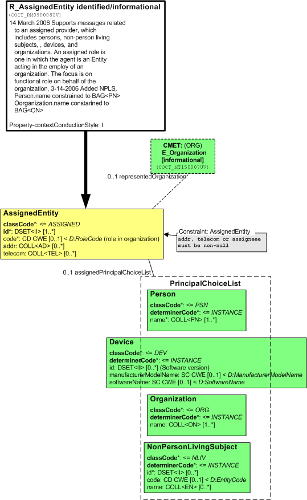
| Parent: | Personnel Management (PRPM_DM000000UV) |
This is the identified/informational variant of R_AssignedEntity universal.
| E_OrganizationInformational | COCT_MT150007UV |
| R_AssignedEntity identified-informational | COCT_MT090008UV |
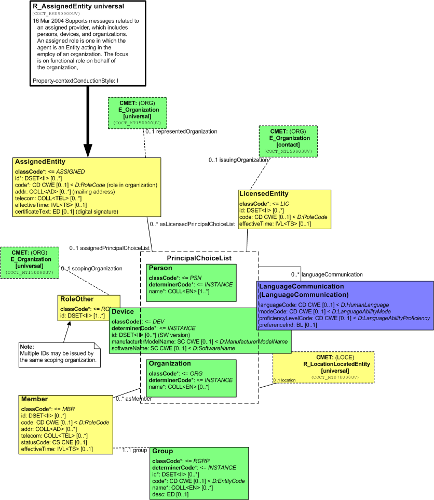
| Parent: | Personnel Management (PRPM_DM000000UV) |
R_Responsible and R_Assigned Entity Refined Message Information Model
The Responsible Entity and the Assigned Entity CMET are both used to capture information about an entity -- person, organization or device -- that is assigned to a particular responsibility within the context of an HL7 message.
R_Responsible vs. R_Assigned: The principal difference between R_Responsible and R_Assigned is that with the former, the role is that of agent, and any entity can be the scoper, but with the latter, the scoper is constrained to be an organization. Thus R_Assigned is a constrained version of R_Responsible.
From the RIM definition, an assigned role is an agent role in which the agent is an Entity acting in the employ of an organization. The focus is on the functional role performed on behalf of the organization, unlike the Employee role where the focus is on the 'Human Resources' relationship between the employee and the organization.
A major use case is for an institution-wide (or organization-wide) role (and the corresponding role attributes, especially the role.ID, which will be the institution-wide identifier). This will support such roles as "staff member", "staff physician", "contracted physician", "contracted nurse", etc. This single role is used for all transactions (interactions) within the institution. For example, at "University Medical Center", Dr. Jones will have a "staff ID number". All acts in which Dr. Jones participates will use the assignedEntity role instance (for which the Role.ID is his "University Medical Center" "staff ID number" to document his participation. Documenting his participations in this manner allows Dr. Jones to have a single Id that he uses within that institution, and also allows the computer applications to easily aggregate any or all acts in which he participates for any particular application reason.
This transaction-related role is not to be confused with the employment relationship the entity has with the organization. Employment relationship examples are full-time, part-time, contracted, temporary, probationary..
It is assumed that the application creating each act will validate Dr. Jones permissions to participate in that act, but it is not necessary to create a new role instance for each of Dr. Jones' permissions (or groups of same). Nor is it necessary to transmit those permissions with each act instance. The receiving application can, if necessary, use Dr. Jones' "staff ID number/assignedEntity role" to validate that he had the necessary permissions to participate in a particular act instance.
Note that the assignedEntity role is distinct from the Personnel Management concepts of position and assignment.
-
Position is an act used to define a named, identified collection of Responsibilities (including Privileges).
-
The Personnel Management concept of assignment is modeled by the participation of a staff member in an act that is an instance of a particular (pre-defined) Position (with its' associated Responsibilities and/or Privileges).
-
Thus, even in Personnel Management, this same single instance of assignedEntity role (with the corresponding institution-wide identifier) can be used.
The following discussion reviews key elements within the CMET:
-
Assigned Entity (role): The role class, assigned entity, captures the critical information of the party playing the role in question. This includes an identifier for the role, mailing address, phone number, and the time within which the role is played. The model identifies zero to one parties playing the role. This supports the case in which information directly related to the playing party is not needed. The role player is captured as a choice of either a person, device or organization. The role is scoped by zero to one organizations. The scoping organization - which like the role player may be omitted if not needed, provides the organizational context for the entity that actually plays the role. For example, the role scoper will normally be the party that assigns the identifier for the role.
-
Entity Choice: As previously noted, the role of assigned entity can be played by either a person, organization or device. At this point, minimal information is captured for each. The reader should also note that it is possible to capture language information for the person, and to identify the location (as shown by the Located Entity CMET) at which the role is generally played.
-
Credentialing (role): The assigned entity may have zero to many credentialing roles. Credentialing captures information for licenses or credentials that may be relevant, and that have been issued to the assigned entity. It is also possible to identify the organization that issued the credential, i.e., the scoping organization.
-
Other Role: The assigned entity may play zero to many other roles. The other role structure makes it possible to capture a list of roles that the entity plays. The scoping organization is also included for these roles.
-
Member (role): The assigned entity may belong to zero to many groups. Information related to the party's membership, and to the group itself is captured.
| R_LocationLocatedEntityUniversal | COCT_MT070000UV01 |
| E_OrganizationUniversal | COCT_MT150000UV02 |
| E_OrganizationUniversal | COCT_MT150000UV02 |
| E_OrganizationContact | COCT_MT150003UV03 |
| R_AssignedEntity universal | COCT_MT090000UV01 |
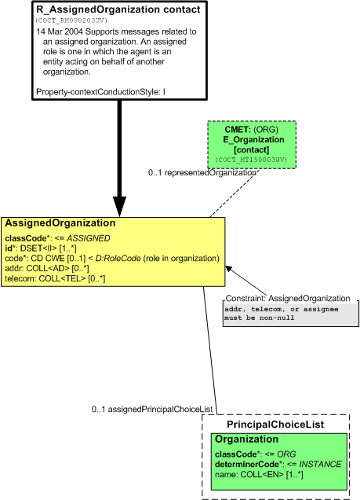
| Parent: | Personnel Management (PRPM_DM000000UV) |
This CMET is used to identified an assigned organization
This is the contact variant of R_AssignedOrganization universal
| E_OrganizationContact | COCT_MT150003UV03 |
| R_AssignedOrganization contact | COCT_MT090203UV01 |
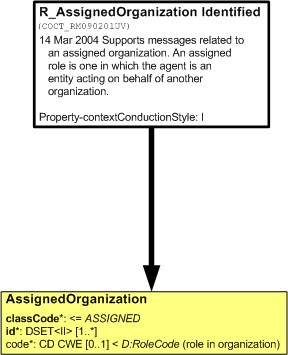
| Parent: | Personnel Management (PRPM_DM000000UV) |
The CMET is used to identify an assigned organization.
This is the identified variant of R_AssignedOrganization universal
| R_AssignedOrganization identified | COCT_MT090201UV01 |
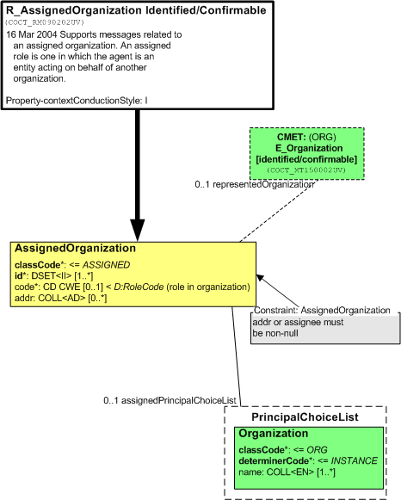
| Parent: | Personnel Management (PRPM_DM000000UV) |
The CMET is used to identify an assigned organization.
This is the identified-confirmable variant of R_AssignedOrganization universal
| E_OrganizationIdentified/confirmable | COCT_MT150002UV01 |
| R_AssignedOrganization identified-confirmable | COCT_MT090202UV01 |
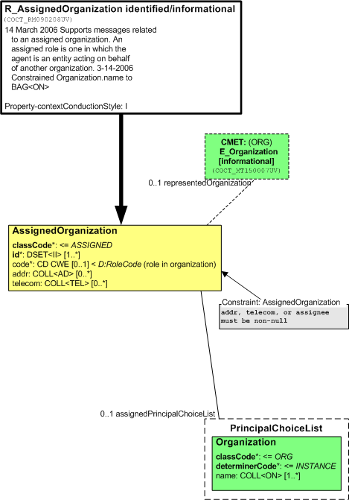
| Parent: | Personnel Management (PRPM_DM000000UV) |
This is the identified/informational variant of R_AssignedOrganization universal.
| E_OrganizationInformational | COCT_MT150007UV |
| R_AssignedOrganization identified-informational | COCT_MT090208UV |
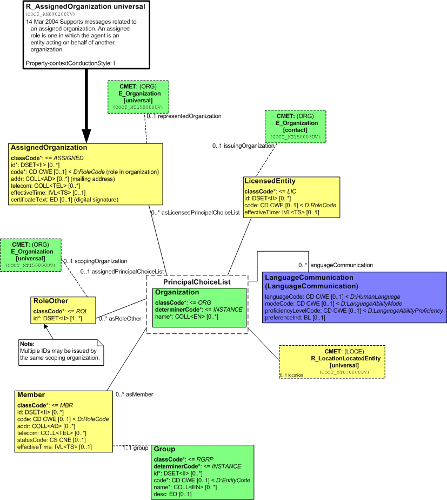
| Parent: | Personnel Management (PRPM_DM000000UV) |
This is the universal variant of the R_AssignedOrganization CMET.
The CMET is used to identify an assigned organization. The CMET also restricts R_AssignedEntity universal by specializing the entity choice to an organization.
| R_LocationLocatedEntityUniversal | COCT_MT070000UV01 |
| E_OrganizationUniversal | COCT_MT150000UV02 |
| E_OrganizationUniversal | COCT_MT150000UV02 |
| E_OrganizationContact | COCT_MT150003UV03 |
| R_AssignedOrganization universal | COCT_MT090200UV01 |
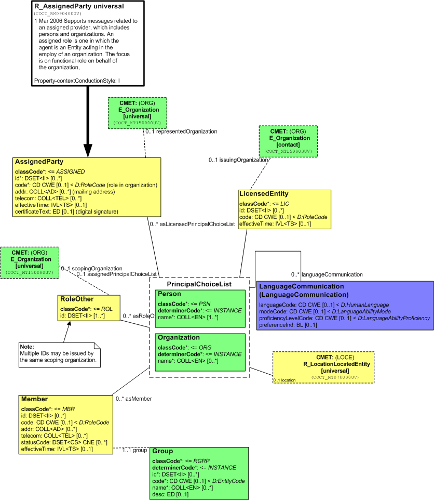
| Parent: | Personnel Management (PRPM_DM000000UV) |
This is the universal variant of the R_AssignedParty CMET.
The CMET is used to identify an assigned party. The CMET also restricts R_AssignedEntity universal by specializing the entity choice to a person or organization.
| R_LocationLocatedEntityUniversal | COCT_MT070000UV01 |
| E_OrganizationUniversal | COCT_MT150000UV02 |
| E_OrganizationUniversal | COCT_MT150000UV02 |
| E_OrganizationContact | COCT_MT150003UV03 |
| R_AssignedParty universal | COCT_MT090400UV |
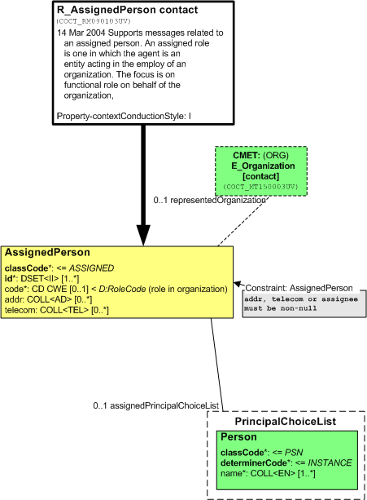
| Parent: | Personnel Management (PRPM_DM000000UV) |
The CMET is used to identify an assigned person.
This is the contact variant of R_AssignedPerson universal
| E_OrganizationContact | COCT_MT150003UV03 |
| R_AssignedPerson contact | COCT_MT090103UV01 |
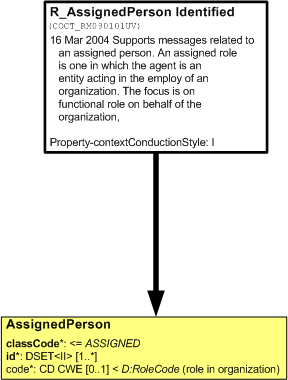
| Parent: | Personnel Management (PRPM_DM000000UV) |
The CMET is used to identify an assigned person.
This is the identified variant of R_AssignedPerson universal
| R_AssignedPerson identified | COCT_MT090101UV01 |
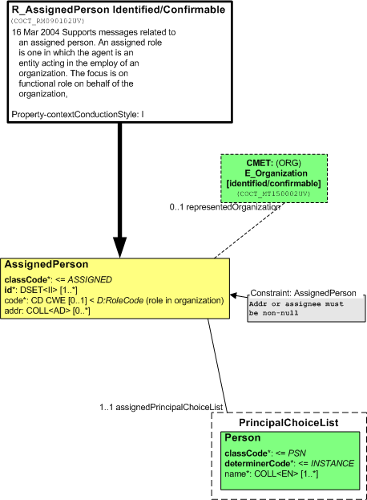
| Parent: | Personnel Management (PRPM_DM000000UV) |
The CMET is used to identify an assigned person.
This is the identified-confirmable variant of R_AssignedPerson universal
| E_OrganizationIdentified/confirmable | COCT_MT150002UV01 |
| R_AssignedPerson identified-confirmable | COCT_MT090102UV02 |
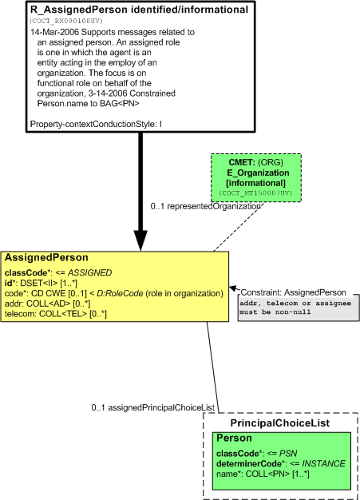
| Parent: | Personnel Management (PRPM_DM000000UV) |
This is the identified/informational variant of R_AssignedPerson universal.
| E_OrganizationInformational | COCT_MT150007UV |
| R_AssignedPerson identified-informational | COCT_MT090108UV |
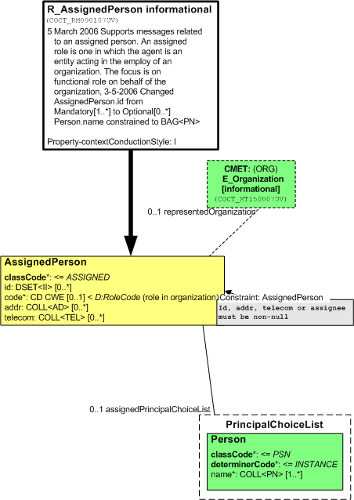
| Parent: | Personnel Management (PRPM_DM000000UV) |
This is the informational variant of R_AssignedPerson universal.
| E_OrganizationInformational | COCT_MT150007UV |
| R_AssignedPerson informational | COCT_MT090107UV |
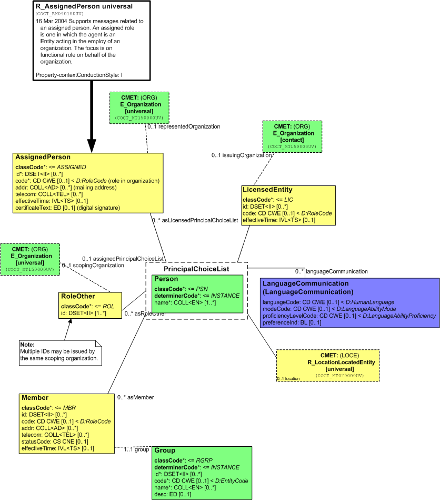
| Parent: | Personnel Management (PRPM_DM000000UV) |
This is the universal variant of the R_AssignedPerson CMET.
The CMET is used to identify an assigned person. The CMET also restricts R_AssignedEntity universal by specializing the entity choice to a person.
| R_LocationLocatedEntityUniversal | COCT_MT070000UV01 |
| E_OrganizationUniversal | COCT_MT150000UV02 |
| E_OrganizationUniversal | COCT_MT150000UV02 |
| E_OrganizationContact | COCT_MT150003UV03 |
| R_AssignedPerson universal | COCT_MT090100UV01 |
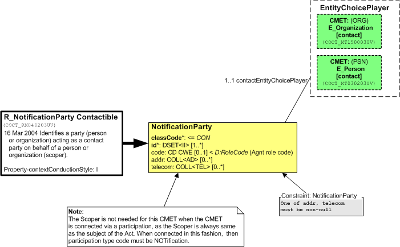
| Parent: | Personnel Management (PRPM_DM000000UV) |
This CMET Identifies a party (person or organization) acting as a contact party on behalf of a person or organization (scoper).
This is the contact variant of the R_ResponsibleParty universal CMET, but additionally constrains the role to that of contact. Contrast to R_ResponsibleParty contact where the role is not constrained.
| E_PersonContact | COCT_MT030203UV07 |
| E_OrganizationContact | COCT_MT150003UV03 |
| R_NotificationParty contact | COCT_MT040203UV09 |
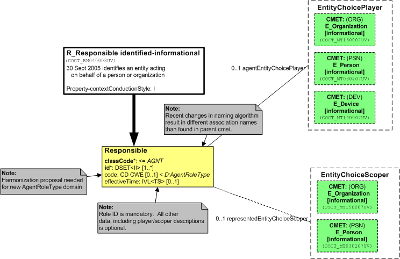
| Parent: | Personnel Management (PRPM_DM000000UV) |
This is the identified/informational variant of R_Responsible universal.
| E_PersonInformational | COCT_MT030207UV07 |
| E_PersonInformational | COCT_MT030207UV07 |
| E_DeviceInformational | COCT_MT140007UV |
| E_OrganizationInformational | COCT_MT150007UV |
| E_OrganizationInformational | COCT_MT150007UV |
| R_Responsible identified-informational | COCT_MT040008UV |
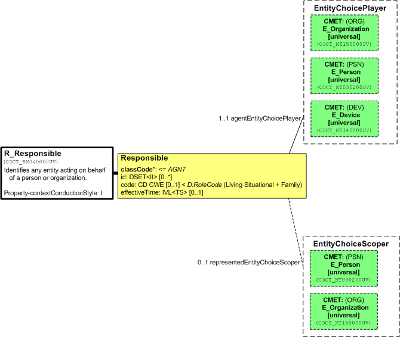
| Parent: | None |
R_Responsible and R_Assigned Entity Refined Message Information Model
The Responsible Entity and the Assigned Entity CMET are both used to capture information about an entity -- person, organization or device -- that is assigned to a particular responsibility within the context of an HL7 message.
R_Responsible vs. R_Assigned: The principal difference between R_Responsible and R_Assigned is that with the former, the role is that of agent, and any entity can be the scoper, but with the latter, the scoper is constrained to be an organization. Thus R_Assigned is a constrained version of R_Responsible.
For further discussion, see R_Assigned
| E_PersonUniversal | COCT_MT030200UV09 |
| E_PersonUniversal | COCT_MT030200UV09 |
| E_DeviceUniversal | COCT_MT140000UV02 |
| E_OrganizationUniversal | COCT_MT150000UV02 |
| E_OrganizationUniversal | COCT_MT150000UV02 |
| R_Responsible universal | COCT_MT040000UV09 |
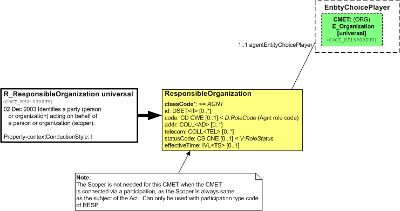
| Parent: | Personnel Management (PRPM_DM000000UV) |
This CMET is the universal variant of the R_ResponsibleOrganization CMET. This is also a constraint of R_Responsible universal, where the agent is constrained to an organization.
| E_OrganizationUniversal | COCT_MT150000UV02 |
| R_ResponsibleOrganization universal | COCT_MT040300UV09 |
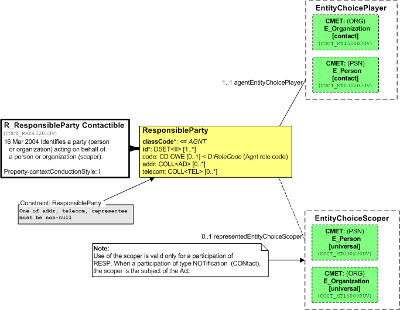
| Parent: | Personnel Management (PRPM_DM000000UV) |
This CMET Identifies a party (person or organization) acting as an agent on behalf of a person or organization (scoper).
This is the contact variant of the R_ResponsibleParty universal CMET. Contrast with R_NotificationParty contact, where agent is constrained to contact.
| E_PersonUniversal | COCT_MT030200UV09 |
| E_PersonContact | COCT_MT030203UV07 |
| E_OrganizationUniversal | COCT_MT150000UV02 |
| E_OrganizationContact | COCT_MT150003UV03 |
| R_ResponsibleParty contact | COCT_MT040205UV09 |
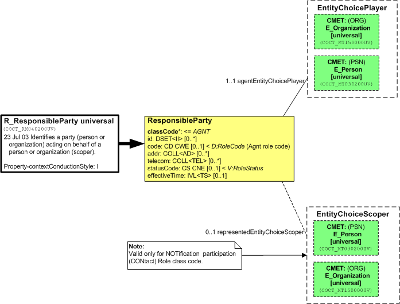
| Parent: | Personnel Management (PRPM_DM000000UV) |
The R_ResponsibleParty CMET identifies a party (person or organization) acting in the role of Agent on behalf of a person or organization.
This CMET is a restriction of the R_Responsible CMET, where the player of the agent role is constrained to a Party, which is either a Person or Organization.
| E_PersonUniversal | COCT_MT030200UV09 |
| E_PersonUniversal | COCT_MT030200UV09 |
| E_OrganizationUniversal | COCT_MT150000UV02 |
| E_OrganizationUniversal | COCT_MT150000UV02 |
| R_ResponsibleParty universal | COCT_MT040200UV09 |
| Return to top of page |


